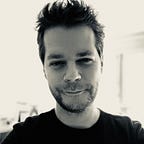The 4 Steps Creative Process
How you can apply it to absolutely anything
Writers, sculptors, coders, and musicians
This morning, as I was having my coffee, I’ve read a Medium article about the process of writing that one of my colleagues at the EPFL Extension School linked to. Here’s the full article by Anupam Krishnamurthy: Separate your writing from your editing. Cool stuff. If you are engaging in any kind of creative endeavor, read it.
There’s a point made about writers working like sculptors in the sense that you start with a block and refine it until the piece is completed. Here’s an excerpt (emphasis mine):
A sculptor visualizes a statue within a block of marble, and chips away to reveal it. She does so in iterations of the whole statue, rather than focusing and refining one part before moving to another. In her first iteration, she carves out the rough dimensions of the statue itself, from head to toe. In the second one, she outlines some details such as the face, the limbs and the torso. In the third pass, specific features such as the eyes, nose and the fingers start to appear. Later, she adds the finishing touches such as fingernails, eyebrows and curls of the tunic.
Still sipping my coffee, I thought that this is exactly how I approach everything that I do. From writing code to composing music and I felt like sharing how I approach this by using a musical context. I’m a big fan of analogies as I believe it is a great vector to convey a concept by using familiar elements.
So, here is my composing process that utilizes these exact same 4 steps.
First iteration: Blocks
Just as the sculptor example, if I’m writing a general theme, I start with blocks (I do it differently when I have to write a motif for a character but that is another article for another day). In this case, the blocks are chords. They are even called block chords. At this point, I don’t even know if I’m going for a heavy metal song or a slow cinematic underscore. Let’s not focus on the details, let’s just get these slabs of stone in place.
This is how it looks like in my editor using MIDI notation:
More importantly, this is how it sounds:
Nothing complicated here. Just some simple triads (three notes chords) with an added bass note. D minor, F, G, B flat, D minor, C, G, D minor. That will serve as the foundation for the track.
Second iteration: Chopping and Carving
The next step is to take these notes and “split” them to add some movement. The block chords only were a bit boring, right? That’s totally normal: a big slab of rock is not really exciting either. At this stage, I start to get an idea of where I want to go by developing a basic rhythmic structure.
This is how the second iteration looks like:
These are still the same block chords. I’ve just chopped the notes a little. This is how it sounds:
Let’s move on to the 3rd iteration. It’s my favorite one.
Third iteration: Emerging features
Again, this is the same process I use to write code or text. For me, this is the most satisfying part of the process. That’s when I add things to carve my piece for it to sound like I want it to sound. Much like the sculptor and the fingers, nose, and eyes emerging, it is at this step that I choose if my track is going to be a soaring romantic cue or a thunderous epic cinematic piece for a film trailer. In this example, I went for “cheesy classic rock”… because why not?
Here, I added notes to the basic harmony, shortened some, extended others, placed some emphasis on the emerging rhythm that will later be supported by the drums, and used some of the codes used in standard rock music. This is how it looks like when this step is completed:
And of course, here is how it sounds:
Can you now feel the movement? Yeah? It’s not a slab of stone anymore? Good. Let’s move on to the last part.
Fourth iteration: Finishing touches
Ok, it may be a little bit more than just a “finishing touch” but because this is a piano-centric track, I treat the other instruments as supporting parts. I’ve added drums by following the same iterative process and then plugged in my bass guitar. The track could stand on its own by using only a piano but it’s these added details that make it unique and hopefully interesting. The same is true if you are building a website: the center part and main point of focus is the message you want to convey but adding a tiny shadow around your containers will make it look more pleasant.
Done. Here is the whole track:
Conclusion
Whether writing prose or code, fleshing out an algorithm, designing a website, or writing music, this 4 steps process is the one I use for any creative task I’m working on. If you want to see how this can be applied to programming, have a look at the EPFL Extension School. Coding is a really creative process as well.
And now my coffee is cold. Thanks Harry for getting my mind wandering a bit too far this morning!
